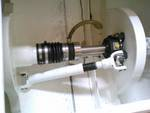markpierce
Master and Commander
- Joined
- Sep 25, 2010
- Messages
- 12,557
- Location
- USA
- Vessel Name
- Carquinez Coot
- Vessel Make
- penultimate Seahorse Marine Coot hull #6
Went out for a three-hour cruise in Carquinez Strait today to exercise the JD, with the benefit of a seal swimming in Mare Island Strait paying no attention to us and the "neighborhood" trawler collecting fish bait, as well as an eagle catching a fish in Carquinez Strait.
Well, entering my berth at the Vallejo Marina, about three-quarters in, I shifted from neutral to reverse to check forward momentum. Then CLUNK, the sound of metal hitting metal! The shift to reverse had no effect, so the 14-ton Coot hit the dock.
The shift to reverse had no effect, so the 14-ton Coot hit the dock.  No damage as speed was slow. Boy, do I have an attentive Guardian Angel!
No damage as speed was slow. Boy, do I have an attentive Guardian Angel!  Hate to think it could have happened elsewhere.
Hate to think it could have happened elsewhere.
After inspection, I found the cause. Can you all propose/guess the cause of my dilemma?
Well, entering my berth at the Vallejo Marina, about three-quarters in, I shifted from neutral to reverse to check forward momentum. Then CLUNK, the sound of metal hitting metal!
 Hate to think it could have happened elsewhere.
Hate to think it could have happened elsewhere.After inspection, I found the cause. Can you all propose/guess the cause of my dilemma?




